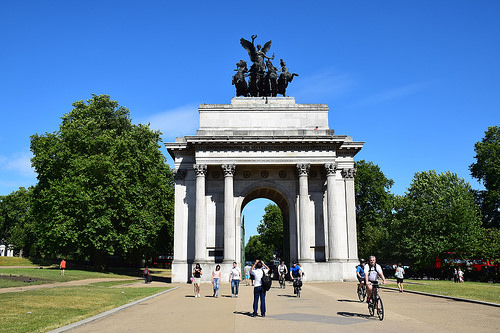Hyde Park Corner
You may hear the name ‘Hyde Park Corner’ and immediately think of a tourist destination within the City of London but in reality Hyde Park Corner itself is actually nothing more than a humble traffic island. It is located at what has to be one of the busiest road junctions in the city, located to the south east of beautiful Hyde Park and is an area of the city which has one of the largest concentrations of memorials and monuments anywhere in London. The junction is where several of the most well known streets in the city converge, namely Piccadilly, Park Lane, Knightsbridge, Grosvenor Place and Constitution Hill. There are a number of tunnels that take pedestrians below the busy surface of the street and of course to the Hyde Park Corner underground station.

Monuments and Memorials
Hyde Park Corner contains a wealth of monuments and memorials, at the centre of which is the Wellington Arch (aka Constitution Arch). A memorial to the infamous Duke of Wellington designed by a man called Decimus Burton to be something of a triumphant gateway through which to enter the city, it was also designed to serve as a northern gate to the grounds of Buckingham Palace. Wellington is also remembered in the form of an equestrian statue, where he is depicted riding ‘Copenhagen’ which was said to be his favourite horse. More modern heroes are also remembered in the area of Hyde Park Corner. There are a number of memorials dedicated to the people that lost their lives during World War I and World War II, for example the Francis Derwent Wood designed Machine Corps Memorial, which is also often referred to as ‘The Boy David’. This is also where you will find the memorial to those who gave their lives in the service of the Royal Artillery during the Great War. The New Zealand and Australian War Memorials are also located here.
Other Aspects of Hyde Park Corner
Other recognisable aspects of Hyde Park Corner are the ‘Hyde Park Corner Screen’ and ‘The Queen Elizabeth Gate’. The screen is located on another large traffic island which is located between Hyde Park and the Piccadilly Gate. Measuring 107ft wide (33m) it consists of three arches which are all joined together by an Ionic colonnade. This is another example of the work of Decimus Burton and was commissioned to be a gateway into Hyde Park. The Queen Elizabeth Gate is a rather modern addition to the collection, as it was commissioned in 1993 in honour of the Queen and instead of being traditionally constructed from carved stone it is composed of bronze and stainless steel, the colours of the materials being enhanced through the natural reaction with the elements around them. Next to the Hyde Park Screen lies Apsley House, the residence of the first Duke of Wellington which is now home to a museum dedicated to his memory. The museum houses a wonderful collection of old masters but perhaps is most famous for the three meter tall stature of a nude Napoleon.

